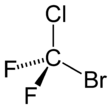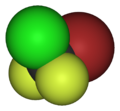Bromochlorodifluoromethane
| |||
| Names | |||
|---|---|---|---|
| Preferred IUPAC name
Bromo(chloro)difluoromethane | |||
| Other names
Bromochlorodifluoromethane
Halon 1211 Halon 1211 BCF BCF Freon 12B1 | |||
| Identifiers | |||
3D model (
JSmol ) |
|||
| ChEBI | |||
| ChemSpider | |||
ECHA InfoCard
|
100.005.944 | ||
| EC Number |
| ||
PubChem CID
|
|||
| UNII | |||
CompTox Dashboard (EPA)
|
|||
| |||
| |||
| Properties | |||
| CBrClF2 | |||
| Molar mass | 165.36 g/mol | ||
| Appearance | Colorless gas | ||
| Density | 7,1362 kg·m−3 (15 °C, 1 bar) | ||
| Melting point | −159.5 °C (−255.1 °F; 113.6 K) | ||
| Boiling point | −3.7 °C (25.3 °F; 269.4 K) | ||
Except where otherwise noted, data are given for materials in their standard state (at 25 °C [77 °F], 100 kPa).
| |||
Bromochlorodifluoromethane (BCF), also referred to by the code numbers Halon 1211 and Freon 12B1, is a haloalkane with the chemical formula CF2ClBr. It is used for fire suppression, especially for expensive equipment or items that could be damaged by the residue from other types of extinguishers.[1] It is stored as a liquid under pressure and vaporizes when discharged to suppress fires.[2] The use of halons, including Halon 1211, has decreased over time due to their adverse impact on the ozone layer. Alternatives have been developed to mitigate environmental concerns while still providing effective fire suppression capabilities.
Use as a fire extinguishing agent
Brominated haloalkanes were first used during World War II in fire extinguishers for aircraft and tanks. BCF was introduced as an effective gaseous fire suppression agent in the mid-1960s for use around highly valuable materials in places such as museums, mainframe rooms, and telecommunication switching centers. BCFs were also widely used in the maritime industries in the engine rooms of ships and also in the transport industry in vehicles. Its efficiency as a fire extinguishing agent has also led it to be the predominant choice of fire extinguishing agent on commercial aircraft and is typically found in cylindrical hand-held canisters. Its advantages as a fire extinguishing agent are that it has lower toxicity than chemicals such as carbon tetrachloride and that since it is a covalently bonded compound, it does not form conductive ions, therefore being usable on electrical equipment.
BCF is an excellent fire extinguishing agent, as it is a streaming agent with low toxicity, a low pressure, liquefied gas, and effective on all common types of fires, A, B, and C.[3][4] It is mainly used in portable and wheeled extinguishers, and small spot protection units for aviation and marine engine applications, and was never widely used in fixed systems like Halon 1301 was.
BCF has fairly low toxicity. The lethal concentration for 15 minute exposure is about 32%.[5]
Synthesis
BCF is commercially synthesized in a two-step process from
Regulation
The production of BCF and similar
Recycling of Halon 1211 allows it to remain in use,
Gallery
-
H-1211 measured by the Advanced Global Atmospheric Gases Experiment (AGAGE) in the lower atmosphere (troposphere) at stations around the world. Abundances are given as pollution free monthly mean mole fractions in parts-per-trillion.
-
Halon 1211 Fire Extinguisher, USA, early 1990s.
-
A portable aviation Halon 1211 fire extinguisher, USA, 2015.
See also
References
- ISBN 978-3527306732.
- ^ "The Halon Advantage". 14 September 2015.
- LCCN 62-12655.
- ISBN 0-87765-377-1.
- ^ )
- PMID 33015672.
- ^ "Basic Facts about Halon". H3R Clean Agents. Archived from the original on 2012-01-04.
- ^ "Recycling Halon". H3R Clean Agents. Archived from the original on 2020-08-09.
External links
- International Chemical Safety Card 0635
- Institut national de recherche et de sécurité (1988). "Bromochlorodifluorométhane." Fiche toxicologique n° 165. Paris:INRS. (in French)
- Aviation fire extinguisher requirements





